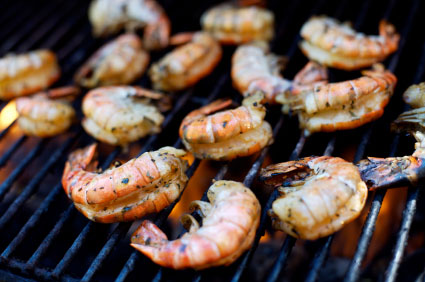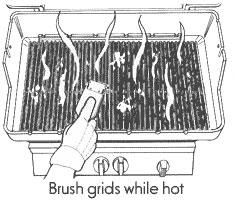This recipe is not a breaded lemon chicken recipe that you might expect from your local chinese restaurant. It is a fantastic zesty marinade. Low calorie too, if you’re into that type of thing. The calories come from only the chicken breast itself and the olive oil to marinade it in.
Mix all the ingredients except the chicken in a bowl. Set aside about 1/3 cup of the marinade that you will use to baste the chicken while it cooks. Add chicken to the bowl, and place in the fridge for 30 mins.
Start up your BBQ, and preheat on high until it is nice and roasty. Discard marinade, and place chicken breasts directly on the grill. Cook for 6 or 7 minutes on each side, until fully cooked. Baste occasionally with the marinade you reserved. The internal temperature should be about 165 degrees or the juices run clear. Chicken breast can easily dry out, so be careful not to leave it on too long. Enjoy!
David B. October 31st, 2011
Posted In: BBQ Maintenance
DIRECTIONS: Wash your fillets in cool water and set aside. Butter Mixture: Melt butter in a bowl and add the juice of one lemon and mix well. Dip your fillets in the butter mixture then generously “slap em’” with “Slap Ya Mama” Cajun seasoning on both sides. Heat a black iron skillet or sauce pan until it’s very hot. Place the fillets in the skillet and cook for about 2 minutes on each side while moving the fillets around to prevent sticking. Remove fillets from skillet and remove the skillet from the burner. While your skillet is still hot, pour the butter mixture and the white wine into the skillet and mix well. Then pour the mixture over the fillets and serve. Source: Slap Ya Mama Recipes.
David B. September 12th, 2011
Posted In: BBQ Maintenance
Here are four ways to prepare your barbecued food. The tips are simple, but should be considered essential to properly grilling food. Once mastered, they will improve your ability to cook barbecued meat beyond mere mortals.
 1. Salt your food properly
1. Salt your food properlyIt is given top-spot in this list for a reason, and probably the most important tip for any form of cooking. Meat needs a lot of salt, probably a lot more than you normally use. Probably a whole lot more. Be generous and experiment. It makes an enormous difference to barbecued meat, and enhances seasonings and the charred flavor enjoyed by any grill lover.
 2. Use freshly ground pepper
2. Use freshly ground pepperLike any spice, preground pepper loses it’s flavor, and particularly it’s aromatic properties, very quickly. I would recommend you try preground pepper and freshly cracked pepper side by side, the difference is huge. Be generous with pepper as well, you don’t need to be subtle when you barbecue.
 3. Spice Rubs
3. Spice RubsSpice rubs add lots of flavor, you can really let out your creative beast. Same deal here, use whole spices and grind them as late as possible. Food should be spiced strongly and with much gusto to balance the grilled taste.
 4. Glazes and Sauces
4. Glazes and SaucesGlazes and sauces are great, and the sweetness does a lot for the charred meat. Just make sure not to make the Cardinal Sin of Glazes and Sauces – putting it on too early. Because of the sugar content it is very easy to burn the glaze and you end up with a sticky burnt mess. Glazes and sauces should only be put on the meat at the end of cooking, such as the last few minutes, or when the meat is taken off.
David B. May 30th, 2011
Posted In: BBQ Maintenance

Rinse the shrimp in some fresh water, and you’re done.
Leave shrimp intact, don’t peel them. The shell protects the meat from overcooking. Leaving the shrimp in their shells not only looks better, but retains the moisture in the meat. Shrimp are the ultimate finger food, which is why you need to rip them apart with your fingers as you eat them. It sounds barbaric, but well, you are eating cooked meat – why not enjoy it?
Brining shrimp takes about 20 minutes.
Pour 1 quart of cold water into a gallon size zip-lock bag. Add two tablespoons of salt. Stir.
Add about 2 lbs of shrimp into the bag, and leave to sit for 20 minutes.
Sometime soon might be a good time to turn your BBQ on to heat up. The barbecue should be on high.
After 20 minutes, drain and rinse the shrimp thoroughly. I recommend you devein your shrimp as it can often give the shrimp a disturbingly gritty texture. To devein while keeping the shell relatively intact, cut the along the back with scissors after brining, and pull out the vein.
Just a couple of tablespoons of olive oil are enough to cover the shrimp.
My current favorite marinade for shrimp:
Just combine in a bowl and mix with the shrimp
Cook the shrimp on high for about 4 to 6 minutes. Turning the shrimp once during the cooking process. This is going to depend a lot on how hot your grill is, and how big the shrimp are. The easiest way to tell if they are ready is when they are barely charred, and bright pink. Enjoy! It’s about time I went to the store to pick up some more shrimp.
David B. February 7th, 2011
Posted In: BBQ Maintenance
Last time I wrote, I posted about Tips about BBQing Chicken. Number 2 on that list was about brining. I received some questions after that post about brining, and I thought it would be worthwhile elaborating on it. So here goes..
First things first, a brine is essentially a salt bath. It marinates the meat far more efficiently than a typical marinade.
In case you are still curious about the process of brining, Wikipedia says:
Brining makes cooked meat moister by hydrating the cells of its muscle tissue before cooking, via the process of osmosis, and by allowing the cells to hold on to the water while they are cooked, via the process of denaturation.The brine surrounding the cells has a higher concentration of salt than the fluid within the cells, but the cell fluid has a higher concentration of other solutes. This leads salt ions to diffuse into the cell, whilst the solutes in the cells cannot diffuse through the cell membranes into the brine. The increased salinity of the cell fluid causes the cell to absorb water from the brine via osmosis. The salt introduced into the cell also denatures its proteins. The proteins coagulate, forming a matrix that traps water molecules and holds them during cooking. This prevents the meat from dehydrating.
Did you get all that? Basically brining allows you to quickly and efficiently add more moisture into your meat, and creates juicier, more delicious grilled meat.
Sounds great right? But too good to be true? Well no.. kind of. The only caveat is that you need to be really careful with cooking. Meat quickly overcooks, and I’ve found you really need to keep an eye on your thermometer for the first few times until you have more experience with the cooking. After a few times cooking brined meat though, you will quickly understand why brining has become one of my goto BBQ techniques. Really do give it a try.
Here is our basic brining recipe again:
Simple brine recipe:
Dissolve salt into water in a gallon zip-lock bag. Add chicken, remove air and seal.
Make sure to use a deep dish, as you want to make sure that the meat is completely submerged.
| Food | Brine Time |
| Shrimp | 30 minutes |
| Whole Chicken (4 pounds) | 8 to 12 hours |
| Chicken Parts | 1 1/2 hours |
| Chicken Breasts | 1 hour |
| Cornish Game Hens | 2 hours |
| Whole Turkey | 24 hours |
| Pork Chops | 12 to 24 hours |
| Whole Pork Loins | 2 to 4 days |
David B. January 12th, 2011
Posted In: BBQ Maintenance
Leak testing your grill is important and only takes a second to do, and all you need is a little water and dish soap. We recommend that you get in the habit of checking this every time you disconnect your cylinder or hose and regulator.
Leak testing must be carried out outdoors in a well ventilated area. Manufacturer instructions should always be followed.
After installing your gas cylinder:
Turn all gas controls to ‘OFF’ and open the gas cylinder valve 1 turn (anti clockwise).
Check all connections with a soap solution of 50% water and 50% liquid detergent. Brush the solution on each gas connection.
Make sure to check the connection at the regulator, which controls the flow of propane to the grill’s burners. These tend to easily get clogged in many modern gas grills.
Soap bubbles will be formed if there is a leak of gas from an improperly sealed connection. Tighten the fitting, re-check, and you’re done.
David B. October 5th, 2010
Posted In: BBQ Maintenance
David B. September 20th, 2010
Posted In: BBQ Maintenance
Rocks or briquettes? The fundamental difference is lava rocks need to be replaced every season or two (depending how long you use them). Briquettes, while more expensive can be turned over and reused. You can buy lava rocks or briquettes here.
Rock & Briquette Maintenance:
What do I need to know about Lava rocks?
Heat Plates:
David B. September 5th, 2010
Posted In: BBQ Maintenance
Cooking grids, when properly maintained, should last for many years. It’s a quick job to maintain it, and should be part of your normal grilling routine.
Ultra-Fast Grid Maintenance Routine:

If you find broken welds, cannot adequately remove rust, or have excessively chipped or missing porcelain, you may opt to replace the cooking grid
David B. August 16th, 2010
Posted In: BBQ Maintenance
David B. August 1st, 2010
Posted In: BBQ Maintenance